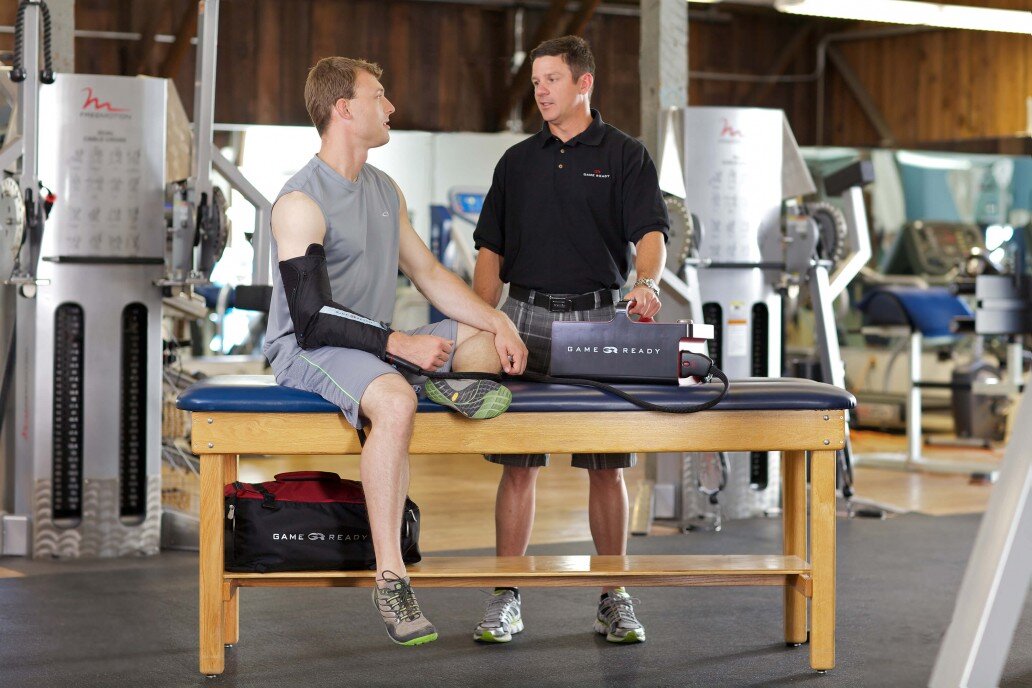Cold Therapy Unit
Photo Credit: GameReady
Help Patients Recover Faster from Surgery
Facilitating faster surgery recovery is not only in the best interest of the patient, but it is also beneficial to surgeons, nurses, physical therapists, and all of the other professionals involved in the rehabilitation process. Hospitals benefit from shorter patient stays, doctors and physical therapists receive more referrals after a positive surgical experience, and a recovery with fewer pain medications poses less risk to the entire system.
How can you help accelerate healing after surgery? Recommend the use of a cold therapy unit during the recovery process. Patients can begin cold therapy almost immediately after surgery to help control the pain and swelling that results from surgical trauma. Administering therapeutic cold as quickly as possible after tissue trauma is proven to help speed up the entire recovery process, so having a cold therapy unit in the hospital is a good start. Of course, the day of the surgery is just the beginning of rehabilitation, so it is important to offer cold therapy options for the duration of the process.
Increase Patient Compliance
After leaving the hospital, the first few days after surgery are critical for the promotion of healing. Convincing patients to get ample rest is typically half the battle, and getting them to actively participate in their recovery by self-administering cold therapy and compression presents another challenge. Many patients find that preparing an ice pack and holding it on the surgical site is both inconvenient and uncomfortable. Static compression bandages are also difficult to apply, and when done incorrectly can lead to further injury.
Giving your patients the option of using a cold therapy unit during physical therapy sessions or renting one for home use will increase compliance and ultimately lead to a faster recovery from surgery. The body-conforming wraps are easy to apply, and depending on where the surgery was performed, patients might even be able to put them on by themselves.
Why a Cold Therapy Machine Accelerates Healing
The therapeutic cold and active compression supplied by a cold therapy machine work together to help you recover from injuries even faster than ice packs or static compression alone.
Because cold therapy machines constantly circulate cold water through an ice reservoir, the temperature remains consistent throughout the therapy session. Adding active compression allows therapeutic cold to penetrate deeper and last longer. This means that all of the benefits described above are enhanced, contributing to faster tissue repair and an accelerated injury recovery.
1. Numbing of nerve endings
Cold reduces the sensitivity of nerve endings, which slows down the communication between your body and your brain, causing you to feel less pain in the injured area.
2. Slowing of cellular metabolism
Therapeutic cold also reduces the activity of cells, which means that the cycle of cell death is slowed down. This reduction in the metabolic rate of damaged cells helps more of the tissues in your muscles, tendons, and ligaments survive the injury, reducing the amount of repair required.
3. Promotion of the hunting response
When your body is exposed to cold, one of the natural reactions is the hunting response, which is the alternating constriction and dilation of the blood vessels. In the context of injury recovery, the hunting response helps reduce cellular metabolism during vasoconstriction and increases delivery of freshly oxygenated blood and nutrients during vasodilation.
If you are interested in learning more about cold therapy units and how they can be used for post-surgical recovery, contact Designed Living today. We provide cold and compression therapy units and specialized wraps for virtually any type of surgery recovery. Whether you are a surgeon, a nurse, or a physical therapist, we are here to guide you through the process of providing a better recovery experience for your patients.

